Want to upgrade your fitness regimen, but don’t have the space for home gym equipment like a squat rack, cardio machine, or free weights? Fear not. The best weighted vests can help you add resistance to an abundance of exercises, giving you a new set of challenges across your favorite bodyweight workouts and cardio sessions.
Now, when you’re literally wearing your training resistance, you want to be sure of a few things. Outside of sizing and weight capacity, it can also be helpful to think about where the weight sits across your profile, as this can influence your training experience and may even limit which exercises you can comfortably perform while strapped up. To keep the purchasing process from weighing down your psyche, we’ve gotten hands-on with a closet full of units and consulted with our in-house experts to compile a list of our favorite weighted vests available today.
The 10 Best Weighted Vests of 2025
- Best Weighted Vest Overall: Rogue Plate Carrier
- Best Adjustable Weighted Vest: Titan Fitness Elite Series Weight Vest
- Best Weighted Vest for Running: Hyperwear Hyper Vest Elite
- Best Weighted Vest for CrossFit: 5.11 Tactical TacTec Plate Carrier
- Best Back-Loaded Weighted Vest: GORUCK Ruck Plate Carrier 3.0
- Most Comfortable Weighted Vest: Omorpho G-Vest
- Best Weighted Vest for Men: TRX Duraballistic Weight Vest
- Best Weighted Vest for Women: Hyperwear Hyper Vest Fit
- Best Weighted Vest for Heavy Training: Kensui EZ-VEST Plate-Loadable Weight Vest
- Best Budget Weighted Vest: CAP Barbell Adjustable Weight Vest
Best Weighted Vests Video Review
Join BarBend expert tester Jake Herod, NASM-CNC as he breaks down our picks for the best weighted vests — including adjustable and back-loaded options — to intensify your strength and cardio training.
How We Tested and Chose the Best Weighted Vests
The BarBend team is made up of competitive athletes, certified personal trainers, and lifelong fitness enthusiasts. To determine the best weighted vests available today, we got hands-on with 16 different profiles from the industry’s best brands, using a multi-point methodology to rate each profile on a scale of 1 (lowest) to 5 (highest). Below are some of the categories and components we looked at to come up with our findings.
Material
Of course, your weighted vest should be constructed from a durable material that can support your intended resistance without succumbing to the weight over time. In addition, you’ll likely want a textile that isn’t too rough or aggressive across your skin, since you will be wearing these fitness tools.
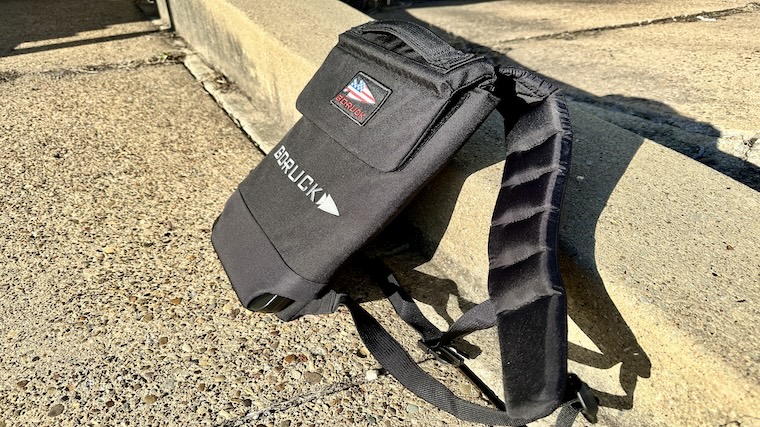
For this round-up, we looked for weighted vests constructed from high-quality nylon or Cordura fabrics, as these have been proven to withstand extended wear and tear — there’s a reason many of the best gym bags are constructed from similar fabrics. We also looked at the design of the shoulder straps and made note of which profiles featured a comfortable fit that could withstand the sweat and stress of regular training.
Loading Pattern
With a weighted vest, the placement of the weight across your frame can also influence your training experience. While you’ll likely want an even distribution for most of your workouts, having the ability to go for a front-loaded or back-loaded setup can be helpful when looking to create new challenges in training.
We looked for weighted vests that offered loading pockets at both the front and back of the silhouette, where possible, for better weight distribution. While some of our picks are more designed for back-loaded training (like a rucking pack), we did want to make an effort to provide as many versatile picks as possible to cater to more athletes and training styles.
Weight Capacity
The weight capacity of your weighted vest is often related to your chosen size, which makes sense. A larger vest can have more room for weight storage pockets. As such, we made sure to note the max weight capacity of each profile in relation to the available size chart.
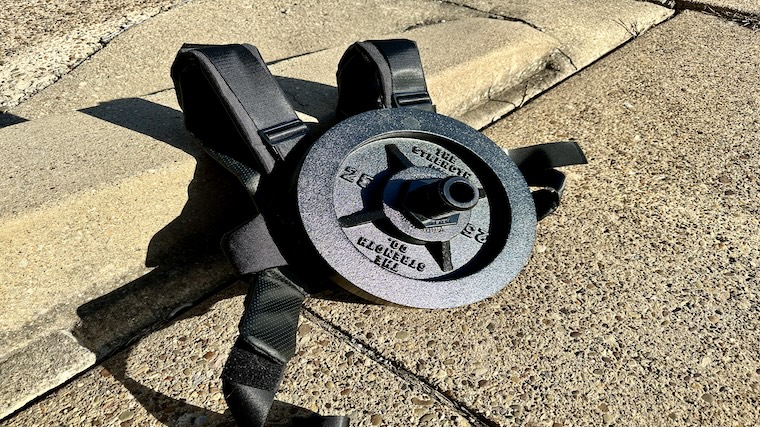
We also examined how easy the vest weights were to change, i.e., how simple and intuitive the pockets were when looking to toggle the working resistance. For example, how many pockets — and thus, how many weight increments — would we need to add or remove to efficiently drop the weight across our chosen vests? For plate-loaded units, how involved would the hook-and-loop security straps be, and could changes be done without much headache?
Fit and Versatility
Amanda Capritto, CPT, CES, CNC, CF-L1, CSNC, states, “If your vest is not fitted correctly, it will flop around, shift, or squeeze you uncomfortably during your workout, in which case you probably won’t ever end up wearing it.”
We made note of how well the sizing options translated to on-body fitment in our findings below. For weighted vests featuring a “One Size Fits Most” design, we made sure to work through the adjustment points along the shoulders and waist to see how true that moniker proved to be.
Having a proper-fitting weight vest can also lend itself to how you actually use the training tool. If your added resistance is snug yet doesn’t hinder your range of motion, you can likely perform more activities than, say, a loose vest that hops and jostles with each rep. We examined which vests offered that comfortable, snug fit that catered to more exercise, along with which profiles would be best suited for more static movements, like dips or pull-ups.
[Related: How to Perform the Perfect Weighted Pull-Up]
Value
No matter your training discipline or fitness interests, having gear that showcases a heightened sense of value is always desirable. When compiling this round-up, we looked for weighted vests offering approachable price points, along with units that would be able to sustain regular use without the need for a replacement purchase down the road.
While weighted vests may be more of an investment than other pieces of budget home gym equipment — you are paying for upwards of 60 pounds of weight, after all — we did our best to find profiles at varying levels to appeal to more financial circumstances. In general, though, you can expect to find a worthwhile weighted vest for anywhere between $80 and $300, with most coming in around $200.
[Related: Best Budget Home Gym Equipment]
Best Weighted Vest Overall: Rogue Plate Carrier

Made of a synthetic fiber-based fabric with breathability in mind, the Rogue Plate Carrier is short enough to avoid restricting your breath. It also offers durable pockets that can hold up to 20 pounds of weight.
Specs
- Price: $135
- Material: 1000D Cordura, 500D Cordura
- Vest Type: Plate-loaded front and/or back
- Weight Capacity: Up to 20lbs per plate pouch
- Available Sizes: Small, Medium, Large
Pros
- This weighted vest uses Cordura fabric across its silhouette, which aids with abrasion resistance and can resist rot and mildew.
- The measurement instructions are clear on Rogue’s brand page, making it simple to find the right size for your individual body type.
- The hook-and-loop strips across the front and back panels allow you to customize your weighted vest with patches aligned to your interests and personality.
Cons
- This weighted vest is only compatible with Rogue-branded rucking plates, and weights are sold separately.
- Athletes wanting to train at resistances over 40 pounds may need to opt for a different vest design.
- According to our tester, the shoulder straps aren’t as padded as other options, which can lead to some discomfort over extended training sessions.
If you’re looking for a simple way to give your calisthenics and bodyweight workouts a new challenge, the Rogue Plate Carrier can deliver. The minimalist design features two front-and-back pockets for rucking plates capable of holding 40 pounds in total. Plus, the Cordura fabric used across the build is plenty sturdy for regular use without showing any signs of wear and tear.
Our tester also appreciated how Rogue clearly explains the sizing options (this Plate Carrier is available in small, medium, and large dimensions). According to the brand, you’ll want to measure 12 inches down from your sternal notch and then take a circumferential measurement around your torso. For torsos less than 34 inches, a small vest should work. Measurements between 34 and 42 inches are best suited by a medium profile. Large vests can accommodate between 42 and 50 inches.
[Related: Your Complete Guide to Bodyweight Training]
Once you have your sizing in order, you’re left with little worry thanks to the durable Cordura fabric. We rated the material at 4.75 out of 5 thanks to its resilient makeup and ability to resist rot, mildew, and abrasions.
Our tester also appreciated the interior design that features minimal stitching, which helps eliminate the chances of any chafing or unwanted rubbing during dynamic movements or hard-nosed sweat sessions.
As inviting as the Rogue Plate Carrier is, though, our tester did drop the construction score to 4.75 out of 5 due to the somewhat flat shoulder straps. “There isn’t a ton of padding across these areas, so while I think you can get by with little irritation during a short training session, I’d highly recommend wearing a shirt underneath if your workouts are going to be lasting more than an hour. Otherwise, you can definitely start to feel the burn,” they added.
Finally, the Rogue Plate Carrier is approachable at $135, but you need to remember that the necessary rucking plates are sold separately. Additionally, this weighted vest is only compatible with Rogue-branded plates, so you’ll need to be mindful of this if you want an optimal fit across each pocket.
As such, we scored the value at 4.25 out of 5. Purchasing plates isn’t the biggest dilemma, but it is a little more time spent shopping online than spent sweating through your new favorite workout discipline.
[Related: Different Types of Strength Training (+ How to Get Started)]
Best Adjustable Weighted Vest: Titan Fitness Elite Series Weight Vest

This Titan Fitness weighted vest utilizes multiple 2.5-pound cast-iron plates across its frame to help boost your training resistance in a sleek, comfortable fashion. Additionally, the extra D-rings allow you to hook into a parachute or training sled for even more uptick when it comes to training intensity.
Specs
- Price: Starting at $79.99
- Material: 1050D Nylon Cordura
- Vest Type: Multi-pocket front- and back-loaded
- Weight Capacity: Dependent on sizing
- Available Sizes: 20lbs, 30lbs, 40lbs, 50lbs, 60lbs
Pros
- This Titan Fitness weighted vest utilizes multiple 2.5-pound cast-iron plates, allowing you to fine-tune your working resistance.
- The chest area and shoulder pads feature extra-thick padding to help improve comfort and relieve pressure.
- There are extra D-rings across the back panel, which can be helpful when trying to add a parachute or running sled to your workout.
Cons
- There are no dimensions for the chest band, leading to sizing questions.
- Our tester states that the weight security could be improved upon — each pocket feels somewhat cheap.
- The thicker shoulder pad design may be too wide for those with narrower shoulders.
Multi-pocket weighted vests can be great for athletes wanting a more fine-tuned sense of resistance in their fitness routine. For our money, the Titan Fitness Elite Series of weighted vests hit all the marks thanks to multiple available weights from 20 to 60 pounds, with each profile using 2.5-pound cast-iron bars to evenly disperse your working total across your chest and back.
Having used this weighted vest, I like how each pocket matches seamlessly to the dimensions of the weight bars. This leaves little room for the weights to bounce around, keeping everything next to the body for fewer distractions and smoother movement. While the pockets themselves feel somewhat frail when compared to the rest of the vest makeup, I still think this can be a useful tool.
[Related: How to Build Muscle and Strength With Calisthenics Training]
Another area where this Titan Fitness weighted vest shines is in the shoulder strap design. These adjustable straps feature a thick padding for improved comfort that doesn’t dig into your clavicles.
I also scored the comfort at 4 out of 5 thanks to the boosted padding across the chest. This extra cushioning helps keep breathing processes more natural (there is added weight across your lungs, after all), allowing you to stay focused on training without the need to gasp for air in-between sets.
There’s also a good bit of versatility baked into this weighted vest thanks to the inclusion of multiple D-rings across the silhouette. We scored the versatility at 4.5 out of 5 because you can take your in-training resistance even further by adding a parachute or training sled to these hook-up points. Other weighted vests don’t typically offer such modularity, or, at least, require a little more DIY innovation to achieve similar setups.
One of the main flaws with the Titan Fitness Elite Series Weight Vest, however, lies in the sizing. The sizes are determined by your max weight (up to 60 pounds), but there are no dimensions on the brand’s site to give you a better indication of how the profile will actually sit across your frame.
We scored the sizing at 3 out of 5 for these reasons, and suggest reaching out to Titan Fitness for any specific measurements (the brand does have a convenient chat tool on the product page for such inquiries).
[Related: 6 Benefits of Sled Pulls]
Best Weighted Vest for Running: Hyperwear Hyper Vest Elite
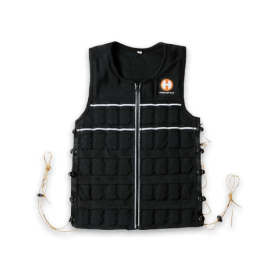
The Hyper Vest Elite features a contoured design and lightweight Cordura makeup that almost feels like you’re wearing your favorite training shirt instead of a weight vest. Depending on your chosen size, you can achieve added resistance of up to 25 pounds, more than enough to help bolster your next sweat session.
Specs
- Price: Starting at $230
- Material: Cordura
- Vest Type: Multi-pocket front- and back-loaded
- Weight Capacity: Up to 25lbs (Dependent on sizing)
- Available Sizes: Small, Medium, Large, X-Large
Pros
- The snug, next-to-skin fit can help eliminate any weight jostling during runs.
- Open side panels can help improve ventilation and breathability.
- The side adjustment cords feature hi-vis reflective strips to help you stay visible during evening runs.
Cons
- Organizing the smaller weight plates can be tricky, especially when trying to get everything into position across the weighted vest.
- The side cords can hang excessively low for some, which may be a distraction when trying to leg out those final miles.
- Our tester said the single stitching and thinner Cordura fabric does leave them questioning the durability.
Weighted vests can also be helpful for runners looking to build muscle and stamina for improved performance on the road. That said, some vests can be rather bulky and serve as more of a nuisance during jogs than a training accessory. The Hyper Vest Elite from Hyperwear, brings a contoured fit to your get-up with a breathable Cordura fabric and open side slits for added ventilation.
In testing, we liked how the lightweight, streamlined design hugged our chest, torso, and back without feeling claustrophobic. “It hugs your body close, but thanks to the thinner Cordura and open side lacing, I never felt constricted during breaths, and still retained my ideal range of motion,” said our tester.
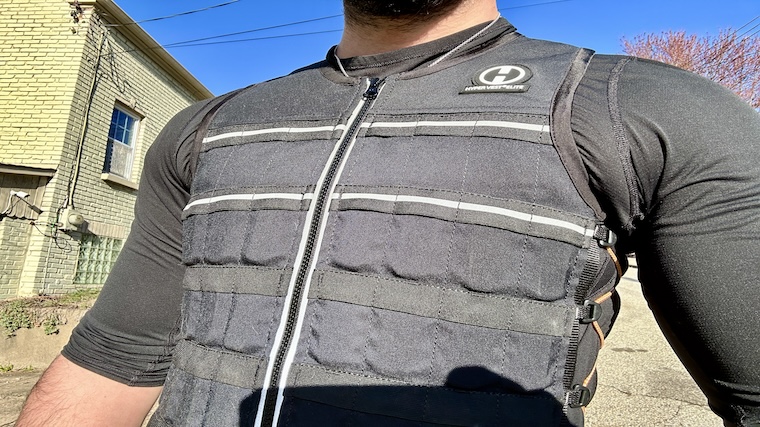
We scored the comfort at 4.5 out of 5, too, thanks to the even dispersal of the thin, removable steel weights that kept our resistance uniform across our front and back.
[Related: Running on a Treadmill Vs. Running Outside — Which Is Best for Your Goals?]
As far as adjustability is concerned, we rated the Hyper Vest Elite at 4 out of 5. The smaller weights allowed us to really fine-tune our setups, but getting the bars into position across the snug pockets can be a bit of a challenge.
Additionally, this weighted vest can only reach maximum weights of up to 20 pounds, depending on sizing. While this may be more than enough resistance for your daily runs, athletes looking for more strength-based training may want to opt for a heavier profile.
The adjustability also stretches to the fit of this weighted vest, which features elastic cord systems across both sides. This can help you achieve that optimal fit for less rubbing or chafing.
Additionally, we like how Hyperwear gave these straps a reflective finish, which can help when trying to stay visible during evening runs on the road. However, there is a good bit of excess cord at the bottom, so we recommend tying up those loose ends before heading out for a multi-mile excursion.
While this weighted vest is constructed from durable Cordura fabric, we still have some reservations about the durability of this profile. Our tester noted that the single stitching used across the design seems weak, and the zipper could be prone to breaks if used excessively. We scored the durability at 3.5 out of 5.
[Related: How To Build Stamina for Running: 6 Tips + Benefits]
Best Weighted Vest for CrossFit: 5.11 Tactical TacTec Plate Carrier
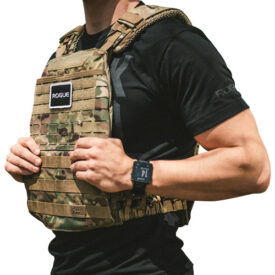
This weighted vest comes in 10 different colors and with the option to add weight plates up to 30 pounds and customize with a variety of patches. They are manufactured with durable, water-resistant, breathable 500D nylon.
Specs
- Price: $215
- Material: 500D Nylon
- Vest Type: Plate loaded front and/or back
- Weight Capacity: N/A
- Available Sizes: One Size
Pros
- The 500D nylon fabric can easily withstand regular use and abuse, making it a great pick for the high-intensity training style of CrossFit.
- There is a convenient one-hand quick-release cable system, which allows you to quickly get out of the vest for other intervals in your WOD.
- The vest is available in multiple colorways, including camouflage.
Cons
- The price is high when compared to other weighted vests, especially since the loadable plates are not included in the $215 original cost.
- Accessories like full MOLLE panels and the Grab-Drag handle are more suited for workforce use than fitness.
- Extender waistbands cost $32, meaning larger athletes may need to make another purchase to achieve an optimal fit.
The best weight vest for CrossFit should be one that’s durable enough for hard-nosed use, yet simple enough to use that you aren’t fussing over the device in-between intervals. The 5.11 Tactical TacTec Plate Carrier has been trusted by CrossFit athletes and service members alike for years thanks to its rugged 500D nylon construction and easy on-and-off construction.
I’ve used TacTec Plate Carriers in the past and appreciate how comfortable the design is, scoring it at 4 out of 5. The multi-banded waistband stretches easily into position, and I’ve never had any issues of pinching or chafing around my clavicles.
It makes sense that these plate carriers are designed with comfort and performance in mind — 5.11 Tactical also serves military and law enforcement personnel. If the gear can withstand the rigors of those environments, I’m sure it’s durable enough for your next sweat session.
In terms of versatility, I’d give the TacTec Plate Carrier a rating of 4 out of 5. There is a good sense of range of motion when wearing this weight vest, making it flexible enough for dynamic movements and even high-intensity WODs like Murph. There are also some built-in features, like a Grab Drag handle for emergency exfiltration, and full MOLLE panels for add-ons like extra storage compartments.
[Related: The Murph CrossFit Workout, Explained and Scaled for Every Experience Level]
Admittedly, though, these may be more aligned with the TacTec’s other audience in the military and law enforcement fields. Unless your WODs call for partner drags across the field, these components may feel like overkill when it comes to your regular fitness regimen.
The 5.11 Tactical TacTec Plate Carrier is more expensive than other similar models at $215, and like other plate carriers, weights are sold separately. Thankfully, though, this plate carrier is compatible with a handful of plate designs, so you can shop around a little for a better deal on resistance loads.
Add-ons like waistband extenders can also be beneficial for larger athletes, but again, they come at an extra cost. Overall, we rated the value at 3.5 out of 5 for this weighted vest.
[Related: Your Guide to CrossFit Benchmark Workouts]
Best Back-Loaded Weighted Vest: GORUCK Ruck Plate Carrier 3.0
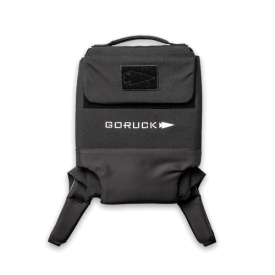
This GORUCK Ruck Plate Carrier 3.0 boasts a durable 1000D Cordura fabric construction that’s capable of supporting up to 45 pounds. Additionally, GORUCK stands behind this training accessory with a Scars Lifetime Guarantee — whether by factory defect or simply by wearing out the device itself, the brand will replace the Ruck Plate Carrier 3.0 free of charge.
Specs
- Price: Starting at $115
- Material: 1000D Cordura
- Vest Type: Plate loaded back
- Weight Capacity: Up to 45lbs (Dependent on sizing)
- Available Sizes: Standard, Long
Pros
- This backpack-style plate carrier features added lumbar support to help keep setups comfortable during your next ruck or workout.
- The weight is centered across your back with little room for jostling for an all-around comfortable fit.
- GORUCK covers this plate carrier with the brand’s Scars Lifetime Guarantee, which warranties the profile for the entirety of its working lifespan.
Cons
- Athletes looking to carry over 45 pounds may want a weighted vest with front and back pocketing.
- This plate carrier doesn’t feature a waist strap.
- There are no extra compartments for added storage for, say, a water bottle or other small rucking essentials.
Back-loaded weight vests are a go-to for rucking, allowing you to keep the weight centered across your shoulder blades and spine to allow for easier breathing at the front. While there are a number of high-quality ruck packs out there, we’re privy to the one with “ruck” in the name. The GORUCK Ruck Plate Carrier 3.0 is the latest iteration of the brand’s tried and trusted profile, boasting tough-as-nails durability, comfortable shoulder straps, and efficient support where you need it most.
I’ve owned the previous model of this rucking pack — the Ruck Plate Carrier 2.0 — for a while now, and after looking at the 3.0, I can see that the durability and performance are still well stitched into this silhouette. I appreciate the top-open cavity that makes loading plates a breeze, and the durable 1000D Cordura still looks as good as it did at unboxing. I scored the durability at 5 out of 5.
[Related: Everything You Need To Know About Rucking (+ How To Get Started)]
I also like how GORUCK includes a sternum strap for a little more stability across the unit during movement, although I feel the overall profile could be enhanced with an added waistband near the bottom of the pack. While I have yet to experience any bouncing or unwanted jostling, extra tie-downs are more often a convenience than not when it comes to adding weight to your bodyweight.
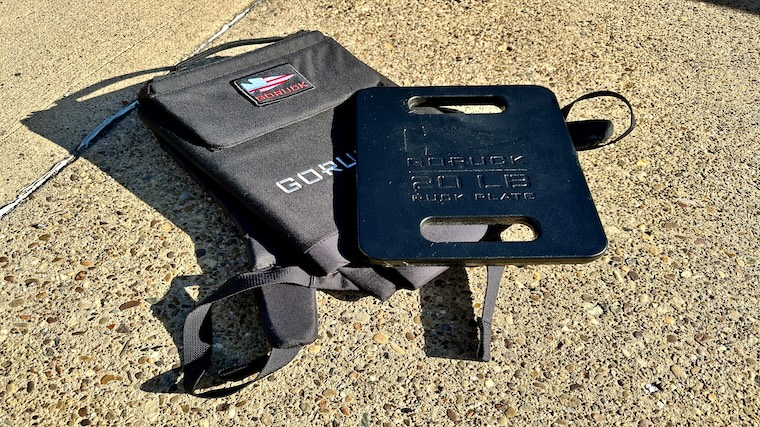
The Ruck Plate Carrier 3.0 can support plates up to 45 pounds (in the longer sizing), which can be more than enough for providing a challenge to your neighborhood walks. This is a slightly higher weight rating than I’ve found in other plate carriers, too, leading to my 4 out of 5 rating for weight capacity. Be mindful, though, that any weight plates will require an extra purchase, so don’t be surprised if your order total goes beyond the $115 starting price for the carrier itself.
While the versatility is lower given the lone back-loading setup — enough for a 3 out of 5 — I still feel this can be an excellent addition to your workout regimen. If anything, you can train without hesitation thanks to the impressive warranty package offered through GORUCK — the Scars Lifetime Guarantee protects the Ruck Plate Carrier 3.0 for life against manufacturer defects, material breakdown, or simply if you pushed the gear to its absolute limit.
[Related: How to Balance Running and Strength Training, No Matter Your Goals]
Most Comfortable Weighted Vest: Omorpho G-Vest
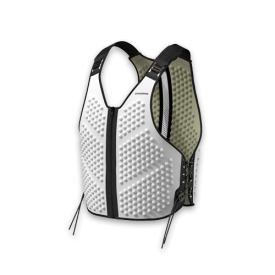
For a comfortable fit and unmatched breathability, it’s tough to beat the G-Vest from Omorpho. The laminated polyester and synthetic rubber blend shapes to your body, while a ventilated back and side-lacing systems help keep you cool as you push toward your next PR.
Specs
- Price: $299
- Material: 100% laminated polyester, synthetic rubber
- Vest Type: Front- and back-loaded encased stainless steel ball bearings
- Weight Capacity: Up to 9lbs, 14oz
- Available Sizes: Small-Medium, Large-XL
Pros
- The polyester and rubber makeup conforms to your body naturally for a snug fit that doesn’t feel too constrictive.
- The zipper and side-cinching cords feature a locking mechanism, which can help keep the vest in place during dynamic movements like burpees.
- The stainless steel ball bearing weights are evenly distributed for a nice sense of resistance.
Cons
- There are no options to add or drop additional weight across the profile.
- The roughly $300 price tag is hefty — other weighted vests typically cost $230 or less.
- Weight totals, at the maximum, are slightly less than 10 pounds, which may be too little of a challenge for some athletes.
Let’s face it — wearing a weight vest can be uncomfortable at times, especially if the silhouette protrudes outward from your frame thanks to the multiple weight bars strewn across the front and back. The Omorpho G-Vest, however, almost feels like a piece of your regular workout attire thanks to a polyester and rubber makeup that sits next to your skin for great flexibility and range of motion.
We rated the G-Vest at 4 out of 5 for comfort thanks to this snug yet not constrictive setup, which kept intensities high without compromising our form and breathing through training. “I also like how the weighted ball bearings conformed to my body’s normal curves,” added our tester. “Plus, the ventilated back can provide better airflow during running endeavors where I’m bound to work up a sweat.”
[Related: The Best Compact Exercise Equipment for Any Small Space]
While this Omorpho weighted vest is lighter than other profiles in the category — the largest size maxes out at 9 pounds, 14 ounces — it is still quite durable. We scored the durability at 4 out of 5 thanks to the resilient polyester frame, as well as the key features like a locking zipper and side-cinch cords. You won’t have to worry about the vest coming undone during dynamic movements, which can help you keep your focus on the tasks at hand.
In terms of who this vest would benefit most, we feel that this can be a great option for beginner athletes looking to up their resistance training. It’s comfortable enough for a wide array of movements, and the roughly 10-pound max can be a more approachable starting point for those just getting the hang of weighted vest movements.
We did dock the versatility to 3.5 out of 5, though, given the fact that the weight total cannot be adjusted (unless you actually cut out some of the stainless-steel ball bearings, which we highly recommend against).
Lastly, we’d be remiss to not mention the price. At nearly $300, this is by no means a cheap piece of fitness equipment, especially when you account for the weight totals of other vests that far surpass the sub-10-pound mark of this G-Vest silhouette. However, if your main concern is comfort while in the throes of training, this can be an excellent accessory to help you up the ante.
[Related: 11 Burpee Variations for Next-Level Muscle Conditioning and Strength]
Best Weighted Vest for Men: TRX Duraballistic Weight Vest
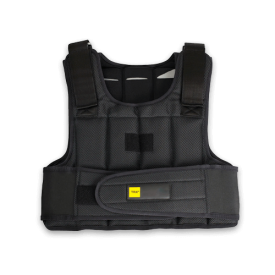
This TRX weighted vest can help you add up to 40 pounds of weight to your regular calisthenics and other training movements while still providing a contoured fit. The cross-strap design along the waist also helps secure the weight to your frame for added security and lockdown, making this a prime pick for dynamic movements like box jumps, burpees, and other endeavors.
Specs
- Price: Starting at $209.95
- Material: Kevlar, Nylon
- Vest Type: Multi-pocket front- and back-loaded
- Weight Capacity: Dependent on sizing
- Available Sizes: 10lbs, 20lbs, 40lbs
Pros
- The “One Size Fits Most” design of this weighted vest can make it more approachable for male athletes of different builds, proportions, and fitness levels.
- The form-fitting design supports dynamic workouts involving jumps, upper-body movements, and changes of direction.
- A unique cross-strap design at the waist helps keep this unit in place during training.
Cons
- This weighted vest features a bulkier silhouette that may not be as ideal for female athletes with smaller torsos. (1)
- The neoprene padding can begin to run hot during extended training sessions.
The TRX Duraballistic Weight Vest is another favorite of ours thanks to a “One Size Fits Most” design that can be more approachable for athletes that may not know the ins and outs of their frame just yet. Additionally, the form-fitting nature of this weight vest can make it an excellent option for dynamic movements — we didn’t experience any weight sloshing or movement that threw us off balance.
Having used this weighted vest in the past, I also see it as a top pick for male athletes thanks to the uniform weight distribution that doesn’t necessarily stress a particular area. I rated the distribution at 4 out of 5, because while you definitely get the sensation that you’re wearing, well, a weight vest, there aren’t any true pain points that make it harder to breathe or raise your shoulders. I’ve worn this unit through plenty of intervals and short runs and have yet to feel any pain points across the profile.
[Related: TRX Strap System Review]
I do recommend this TRX profile more for men, though, because the shape is somewhat bulky, despite the overall fit. This could be a detriment to female athletes, who, on average, feature smaller torsos and more narrow shoulders. (1)
As far as durability, this vest earned a 4.5 out of 5 in testing thanks to its neoprene-lined interior and nylon exterior. TRX also fortified the profile with Kevlar for a silhouette that can take a beating.
However, this resilient construction did compromise some comfort. Over time, the neoprene material across the interior can begin to heat up, leaving you drenched in sweat. The thicker shoulder straps also factored into my 3.5 out of 5 comfort score. While I haven’t had an issue in keeping the vest in place, I could see how the OSFM design could be too much to manage for narrower shoulders. This, in turn, can limit the vest’s versatility to more static movements like push-ups or dips.
It should also be noted that TRX does not offer additional or replacement weights for this Duraballistic profile. So, if you do end up taking some of the load out to achieve a lighter frame, make sure to organize the weights in a way that they won’t disappear before it comes time to add them back in.
[Related: Learn the Best TRX Exercises for Your Experience Level]
Best Weighted Vest for Women: Hyperwear Hyper Vest Fit
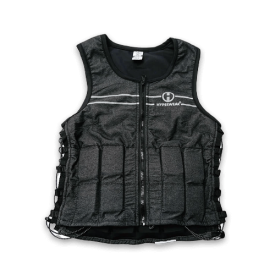
The Hyperwear Hyper Vest Fit keeps all of the weight centered around the abdomen and back, keeping the chest open for improved breathability and comfort. Additionally, the side-strap system helps you contour the profile for that premier fit day in and day out.
Specs
- Price: Starting at $83.99
- Material: Cordura
- Vest Type: Multi-pocket front- and back-loaded
- Weight Capacity: Up to 10lbs
- Available Sizes: Small, Medium, Large
Pros
- This Hyperwear vest centers all of the weighted bars toward the abdomen and back, leaving the chest area open for a more comfortable fit.
- Open side panels help improve ventilation.
- The one-way stretch technology across the Cordura fabric helps minimize jostling and bouncing during movement.
Cons
- The 10-pound max weight may be underwhelming — our tester notes that most CrossFit workouts call for a 14-pound vest for women.
- The side lacing system can leave you with a lot of excess cording once cinched down for workouts.
- We found the zipper to be less durable than desired.
The female body is different from that of a male, so having a weighted vest that works with the proper dimensions can go a long way in keeping things comfortable in training. The Hyper Vest Fit from Hyperwear is perhaps the best example of this. Not only is the cut of the vest designed to contour to a female body better, but the actual weight is distributed across the abdomen and back, keeping the chest free for easier fitment and breathability.
While our tester wanted to see a higher weight total across the design — this weight vest maxes out at 10 pounds — they still rated the versatility at 4 out of 5. “The standard prescribed weight for CrossFit workouts is a 14-pound weighted vest for women, so this Hyperwear pick wouldn’t be a proper solution for any CrossFit ladies out there. However, I think it’s a solid choice for any woman looking to add a bit of weight to their walks, runs, hikes, or bodyweight workouts,” they added.
[Related: Women Get More Health Benefits From Regular Exercise Than Men, New Research Suggests]
Despite the weight capacity earning a 2.5 out of 5 from our trials, we were still happy with the vest’s adjustability. We scored the Hyper Vest Fit at 4 out of 5 for the category thanks to its sleek multi-pocket design, as well as the side lacing system that can help you better achieve that optimal fit across your torso.
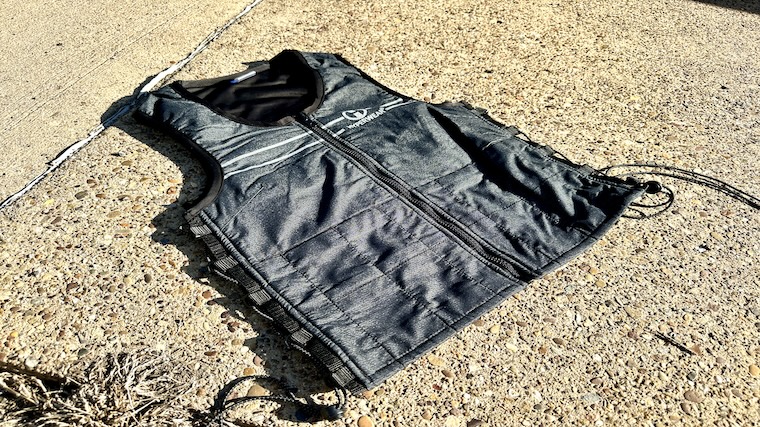
Like other Hyperwear vests, though, we found that there is a lot of excess cord at the tail end of the setup, so be sure to tie a knot into these strands before getting into a dedicated session.
We experienced minimal bouncing when going through the motions with this weighted vest, which we attributed to the one-way stretch makeup of the durable Cordura fabric. This can be great for keeping everything in place during runs or dynamic movements, while also facilitating a more contoured fit. However, the Cordura is lighter than other weighted vests, so you may want to take things easy until you get the hang of what this silhouette can bring to your training regimen.
[Related: Best Workout Apps for Women]
Best Weighted Vest for Heavy Training: Kensui EZ-VEST Plate-Loadable Weight Vest

For strength athletes looking for a unique way to up their in-training resistance, the Kensui EZ-VEST can be just the ticket. Using standard weight plates instead of rucking plates or smaller weight bars, this vest can help intensify your pull-ups, push-ups, and dips by up to 300 pounds.
Specs
- Price: Starting at $99
- Material: 1680D military-grade nylon
- Vest Type: Weight plate loaded front and/or back
- Weight Capacity: Up to 300lbs
- Available Sizes: Lite V2, Pro V2, Max V2
Pros
- This loadable weight vest can hold multiple weight plates across its front and back posts for a total of up to 300 pounds — other vests typically max out around 60 pounds.
- Each weight post features a screw-on lock to keep your loaded plates in place.
- The underarm straps feature a quick-release locking mechanism.
Cons
- Admittedly, it can be difficult to get this vest on with large plates already secured to the front and back posts.
- You may experience some pinching across the clavicles where the front and back shoulder straps overlay.
- Placing larger weight plates, like a 45-pound plate, on the front or back post can limit your range of motion.
If you’re looking to move with heavy weights strapped to your frame, this is the weighted vest of choice. Instead of relying on pre-cast rucking plates or loads of smaller bars, the Kensui EZ-VEST has you strap literal weight plates to the design. The simple yet efficient profile features weight sleeves at the front or back, too, allowing you to evenly disperse the weight across your upper body (provided you have a matching pair of weights). All told, it’s capable of supporting up to 300 pounds.
The EZ-VEST is my current go-to weight vest for at-home workouts because it helps me utilize my available free weights more in training outside of barbell work. Getting the weights into position Is a breeze, and I scored the screw-on locking mechanism at 4 out of 5 for its security. I’ve performed various dips, pull-ups, and push-ups with this unit and never worried about the weight plates coming undone.
[Related: High Volume vs. Maximum Intensity: How to Choose?]
As far as the weight capacity, Kensui states that this weight vest can support up to 300 pounds. While that’s good enough on paper for a 4 out of 5 rating, I will say that 300 pounds in reality can be a bit of a bear to get into.
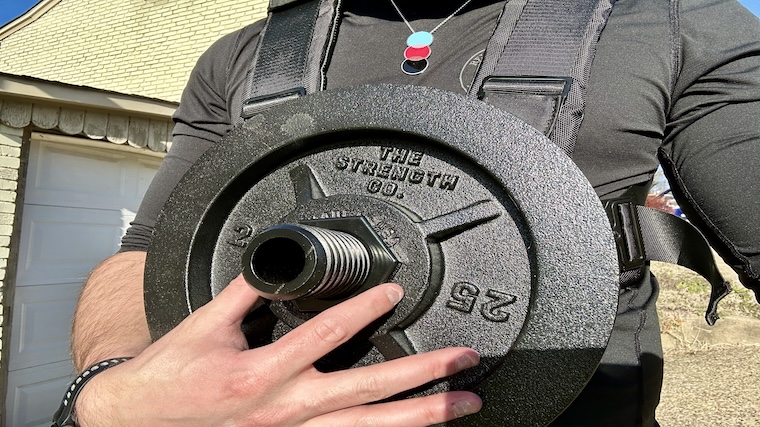
At that weight, you’ll need multiple 45s on each weight sleeve, along with a few helping hands to actually secure the device to your frame. If you can train at this intensity, good for you, but athletes simply looking at the numbers and thinking they can train with this extra load may be in for a rude awakening.
This also leads me into my point on versatility. I scored the EZ-VEST at 3.5 out of 5 given the silhouette you’re left with once you’ve added the weight. I love the quick-release locks on the sternum straps, but you are still left with a large disc on your front or back, depending on where you decide to load the weight.
This can alter your range of motion significantly, either by shortening your fly plane or literally jutting up in front of your face. As a result, I would reserve this EZ-VEST for more static exercises like dips or pull-ups where you’re not moving as quickly through a given movement (no sense in tasting your weight plate mid-workout).
[Related: Best Weight Plates]
Best Budget Weighted Vest: CAP Barbell Adjustable Weight Vest
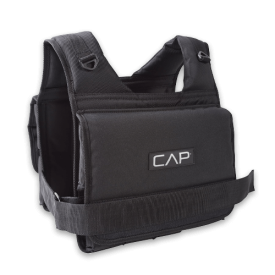
This budget-friendly weight vest from CAP Barbell comes in varying sizes up to 150 pounds for a wide range of training resistances. Plus, the multi-pocket design helps disperse the weight more evenly across your frame, helping improve your in-workout comfort as you work up a sweat toward your fitness goals.
Specs
- Price: Starting at $79.99
- Material: Reinforced nylon, polyester
- Vest Type: Multi-pocket front- and back-loaded
- Weight Capacity: Up to 150lbs
- Available Sizes: 20lbs, 30lbs, 40lbs, 50lbs, 60lbs, 70lbs, 80lbs, 100lbs, 120lbs, 150lbs
Pros
- You can purchase this weight vest at its lowest available resistance for less than $80 with the weights included — other vests can cost over $100 for the shell alone.
- There are weight options available up to 150 pounds for a wide range of training resistances.
- Thanks to its Amazon availability, you can save on shipping with a paired Prime account.
Cons
- Sizing is determined by your chosen max weight, meaning those with smaller frames could be swimming in a chosen profile.
- Weight is distributed below the waist strap, which can lead to some unwanted flopping and bounce during more dynamic movements.
- According to our tester, the reinforced nylon material is less durable than other options in the category.
Weighted vests can be somewhat expensive, with some coming in at over $200 for the vest shell alone (not including the actual weight). Thankfully, though, there are some wallet-friendly options on the market, like this CAP Barbell Weighted Vest. For less than $80, you can get set up with a reinforced nylon vest and 20 pounds of weight — a true bargain when compared to profiles that can sometimes cost up to $300.
Naturally, you can expect to pay more as the weight increases, but having options as high as 150 pounds also adds to the value of this weight vest. You can truly push your potential without needing to wear multiple units at once — other weight vests typically max out around 40 or 60 pounds.
For these reasons, we rated the value at 4 out of 5. Additionally, given that this weighted vest is available on Amazon, Prime members can potentially reap more savings thanks to free shipping offered through the service.
[Related: The 9 Best Treadmills on Amazon]
Of course, though, this CAP Barbell weighted vest isn’t as perfect as the price may seem. According to our tester, “This is a unisex, one-size-fits-all design, so I’d be cautious if you have a very petite frame, as you might find yourself swimming in the vest, making it nearly useless for training needs.”
Plus, we rated the durability at 3.5 out of 5 after noticing that the weight pockets are thinner than other vests we’ve tested. Yes, they can hold the adjustable loads just fine during less intense workouts, but we’re concerned about how the textile would fare in high-intensity sessions like you’d see in a dedicated CrossFit schedule.
As a final note, while this weighted vest does feature a waistband for added security, some of the loaded weight is housed below this belt, creating a sort of apron at the point of lockdown. These lower weights can begin to flop and jostle during dynamic movements, resulting in a drop in comfort and versatility. We scored the versatility at 3.5 out of 5.
[Related: How Much Cardio Is Too Much? Running Coaches Weigh In]
Benefits of Weighted Vests
According to Amanda Capritto, CPT, CES, CNC, CF-L1, CSNC, “Weighted vests are high on my list of favorite fitness equipment. I love them for their portability and minimal storage space requirement.” Apart from their smaller footprint, below are a few more of our favorite benefits associated with these helpful fitness tools.
Boosted Cardiovascular Fitness
One of the easiest areas to see the benefits of weighted vest training lies in cardio. When you wear a weighted vest, you’re adding more strain to your lungs and frame, which results in your body needing to work harder to maintain a proper breathing cycle and movement form. While this can be taxing on your body, you can slowly become accustomed to these stressors, resulting in better cardiovascular output and strength overall.
[Related: Best Treadmills for Home]
A weighted vest can also help you gain speed, according to studies. (2) The best comparison we can give is to a bat donut in baseball. These small weights add to your bat’s overall weight for practice swings, but when it comes time to hit, your body has grown accustomed to the extra weight.
As a result, your actual swing feels faster through the strike zone. So, if you’re trying to shave off a little bit of time from your fastest mile, you can think of training with a weighted vest as a “running donut” for when it comes time to measure your PRs again.
Body Composition
While not everyone is aiming to change their body composition by lowering body fat, it might be a goal some athletes share. Research suggests that using weighted vests might be able to help athletes burn more calories in a given workout.
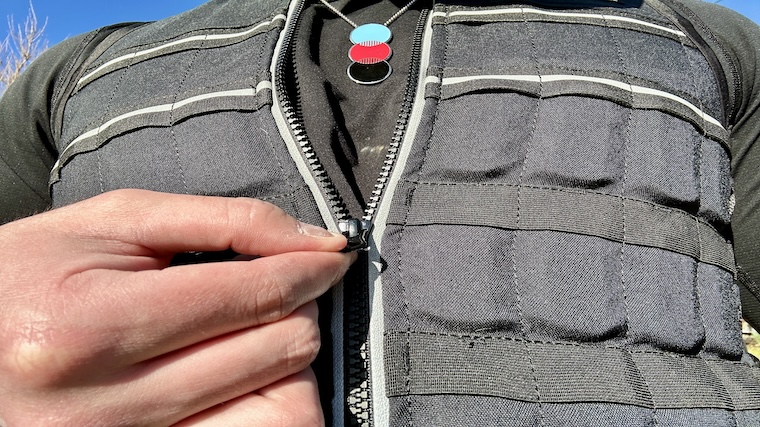
A 2006 study found that 4-minute bouts of walking while wearing weighted vests ranging up to 20 percent of participants’ body mass can increase energy expenditure. (3) In other words, it may cost your body more energy to walk with a weighted vest than without one, which can potentially help fuel changes in body composition.
Improved Strength
Of course, resistance training, regardless of how you employ it, can lead to improved muscle strength and growth over time. Rather than relying on a set of free weights or fancy cable machines to provide the stress, weighted vests literally strap the resistance to your existing bodyweight. As a result, you’re required to move through your normal movements with an excess load, which can provide more than enough challenge to support muscle growth.
[Related: What You Need to Know About How to Build Muscle]
As your muscle fibers heal and enter hypertrophy — the enlargement of the muscle tissue — these activities can become easier as you grow accustomed to the strain. As a result, your unweighted movements can feel easier and less taxing overall, leading to better performance and results throughout your fitness regimen.
How Much Do the Best Weighted Vests Cost?
Unlike the best cable machines, for instance, weighted vests are generally a more budget-friendly piece of equipment. That being said, athletes shopping on a budget can still find and purchase more cost-friendly vests. Use the chart below to compare prices across products.
| Best Weighted Vest Overall | Rogue Plate Carrier | $135 |
| Best Adjustable Weighted Vest | Titan Fitness Elite Series Weight Vest | Starting at $79.99 |
| Best Weighted Vest for Running | Hyperwear Hyper Vest Elite | Starting at $230 |
| Best Weighted Vest for CrossFit | 5.11 Tactical TacTec Plate Carrier | $215 |
| Best Back-Loaded Weighted Vest | GORUCK Ruck Plate Carrier 3.0 | Starting at $115 |
| Most Comfortable Weighted Vest | Omorpho G-Vest | $299 |
| Best Weighted Vest for Men | TRX Duraballistic Weight Vest | Starting at $209.95 |
| Best Weighted Vest for Women | Hyperwear Hyper Vest Fit | Starting at $83.99 |
| Best Weighted Vest for Heavy Training | Kensui EZ-VEST Plate-Loaded Weight Vest | Starting at $99 |
| Best Budget Weighted Vest | CAP Barbell Adjustable Weight Vest | Starting at $79.99 |
How to Choose the Best Weighted Vests
As with any piece of training equipment, your decision to purchase a weighted vest goes beyond just the amount of weight you’re looking to work out with. Below are a few key components to think through before finalizing your cart.
Sizing
One of the first things to consider when it comes to weighted vests is the actual size of the unit itself. There is no sense in strapping extra resistance to your frame if it’s ill-fitting from the start.
Pay close attention to any sizing guides available online, and look for a vest that fits your dimensions best. This may require you to take some measurements around your chest and shoulders, so a tape measure may be needed to find the accurate metrics for your given profile.
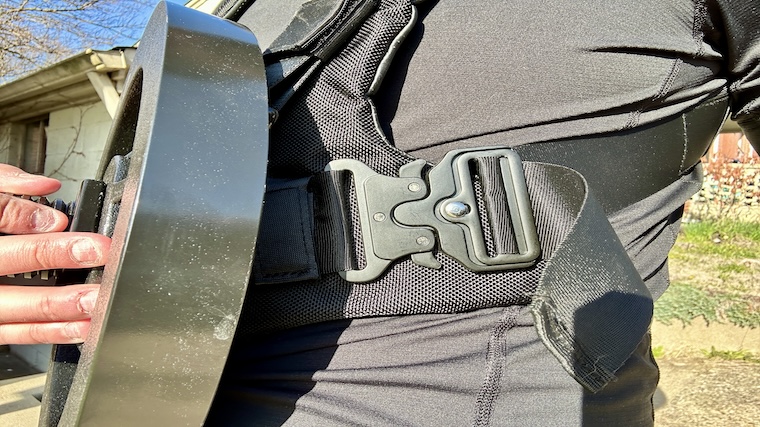
Oftentimes, though, weighted vests will come in a “One Size Fits Most” design. For these instances, we recommend looking for easy adjustment points along the shoulders and waist, as this is where you’ll be fine-tuning your fitment to avoid any unwanted weight bounce or shifting during movement.
Loading Style
When you’re getting ready to buy a weighted vest, make sure you’re also paying attention to the way it distributes the load. If you don’t like tight material around your stomach, you probably want to go for a short vest or one that is completely back-loaded to provide the most accommodating fit.
[Related: Do These 5 Things Between Sets to Build More Muscle and Burn More Fat]
On the other hand, if you’re looking to give your core an extra challenge, you might want the option of front-loading the weight. If you’re looking for a vest to help you run the gamut of bodyweight and barbell exercises, even-loading might be best for you to help keep your balance when it counts.
Training Goals
Your weight vest can prove to be impactful in your training, but the fitment may not be as efficient, depending on your fitness interests. According to Amanda Capritto, CPT, CES, CNC, CF-L1, CSNC, here are the groups that could benefit most from adding a weighted vest to their workout ensemble:
- Beginners who are ready to progress from bodyweight workouts to weighted workouts.
- Long-distance hikers who need to train with weight.
- Calisthenics enthusiasts.
- CrossFitters.
- People who travel frequently and want to bring weight along.
Essentially, this is to state that weighted vests can be most impactful for athletes that regularly move their body through their regimen. We’re not saying that yoga enthusiasts or dedicated powerlifters couldn’t benefit from throwing on a weighted vest, but we believe the above groups would see the most performance benefits.
Weight Options
The weight of your vest applies to two considerations — how the weight is actually designed and how much is strewn across the profile. Most weighted vests utilize pre-cast rucking plates that weigh a rounded number, often between 5 and 30 pounds.
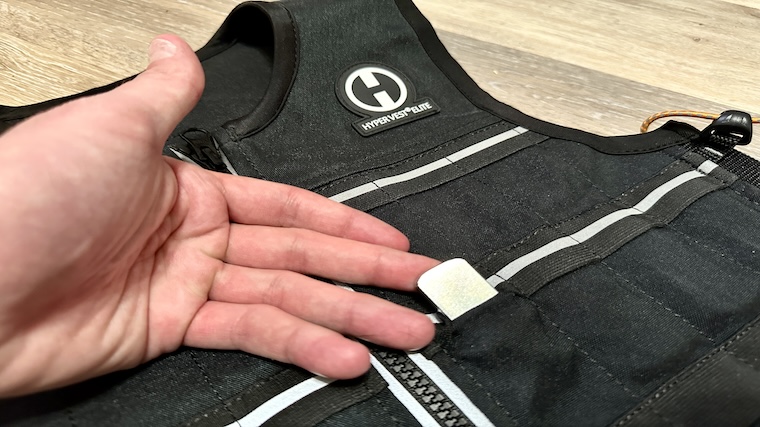
Other designs use smaller weights at a higher quantity, parceled out across the silhouette in individual pockets. While there is a little more adjustability with the multi-pocket design, it is ultimately up to you in terms of which profile you prefer.
[Related: Cardio Vs. Strength Training — Which Is Better for Your Goals?]
You’ll also need to think about how much weight you want to train with, and how much of a challenge you’re looking to bring to your regimen. You can find most adjustable weighted vests in weights from 5 to 60 pounds, with some even capable of supporting loads up to 300 pounds.
According to studies, a good general rule for safety is to use no more than 10% of your body weight. (4) Think of this as a good starting point with room to adjust based on your training interests and strength levels.
Final Word
If you’re looking for a new way to give your workouts a fresh sense of challenge, weighted vests may be a perfect addition to your training setup. While compact and wearable, these impressive profiles can help you significantly up the ante when it comes to normal bodyweight movements, and even serve as a new layer to your cardio regimen through taxing carries and stamina training.
Before selecting a weight vest of your own, be sure to think about your personal training goals, and whether added resistance is the best fit. If so, be sure to look for a profile that offers some flexibility in terms of the working weight, along with a silhouette that’s comfortable and resilient enough for regular wear. Using this round-up as a guide, you could be well on your way to turning the intensity up a notch in your next calisthenics session or neighborhood run.
FAQs
How heavy should my weighted vest be?
According to studies, a good general rule for safety is to use a weighted vest that’s no more than 10% of your body weight. (4) As with most strength-training endeavors, you can curate your training loads to your personal preferences, but it can be helpful to start lighter and work your way up, especially since added weight across your frame is a new sensation you’ve likely never felt in a training setting before.
How much do weighted vests cost?
Weighted vests can cost as low as $80 and as high as nearly $300, with many falling in the $100 to $200 range. However, you need to be mindful that some weighted vests do not come with the weights themselves, but instead are just a durable shell for weight carrying. You may need to purchase your weights separately to achieve your desired setup.
How do I get started using a weight vest?
If you’re intending to do cardio with a weighted vest, plan to start very slowly. After you’ve selected your weight, begin by walking with your vest before jogging and running. Just as you would program progressive overload in the gym, do the same with your weighted vest. Make sure you adapt to walking, then jogging, then running — all with excellent form — under weighted conditions before moving up in weight.
Similarly, if you’re planning to lift weights with a vest, start slow. Incorporate the weighted vest into your warm-up sets, perhaps avoiding incorporating it into your heavier sets until your body gets acclimated.
What is the best weighted vest?
That depends mostly on what you’ll be using the vest for, whether it be running, bodyweight exercises, a combination of the two, or other conditioning exercises. Our favorite at the moment is the Rogue Plate Carrier thanks to its streamlined fit, durability, and stability.
What kinds of exercises can I do with a weighted vest?
As long as the vest you’ve chosen is conducive to your desired activity, you can perform a wide range of exercises with weighted vests. These include running, sprinting, and weightlifting, as well as a large array of bodyweight exercises, like pull-ups and push-ups.
References
- Bredella, M. A. (2017). Sex differences in body composition. Sex and Gender Factors Affecting Metabolic Homeostasis, Diabetes and Obesity, 1043, 9–27. https://pubmed.ncbi.nlm.nih.gov/29224088/
- Macadam, P., Cronin, J. B., & Feser, E. H. (2019). Acute and longitudinal effects of weighted vest training on sprint-running performance: a systematic review. Sports Biomechanics, 1–16. https://pubmed.ncbi.nlm.nih.gov/31070108/
- PUTHOFF, M. L., DARTER, B. J., NIELSEN, D. H., & YACK, H. J. (2006). The Effect of Weighted Vest Walking on Metabolic Responses and Ground Reaction Forces. Medicine & Science in Sports & Exercise, 38(4), 746–752. https://pubmed.ncbi.nlm.nih.gov/16679992/
- ISSA. (2022, April 6). What to Know Before Buying a Weighted Vest for Your Workouts | ISSA. www.issaonline.com. https://www.issaonline.com/blog/post/what-to-know-before-buying-a-weighted-vest-for-your-workouts